Customer service directly impacts your bottom line. Clients who are satisfied with your products, services, and customer support become repeat customers, increasing overall sales. Therefore, providing reliable and high-quality customer service must be a part of your overall business strategy. In this article, we share 40 relevant customer service statistics revealing how exemplary customer support fosters stronger customer relationships and business success.
Customer Trends & Behavior Statistics
Understanding customer behavior is essential for businesses because it enables them to identify the needs and expectations of their customers. The following customer service stats demonstrate common behaviors and tendencies of consumers and what influences them to make a purchase.
1. 76% of customers would switch to a competitor due to multiple poor customer service experiences.
Takeaway: Not working to improve the quality of your customer service is costly. One of the negative effects of bad customer service is the loss of valuable customers. It also encourages them to switch and try your competitors’ offerings instead.
(Source: Zendesk)
2. 79% of businesses agree that customers are now smarter & more informed than ever before.
Takeaway: With easier access to information, customers now have higher expectations from service teams. This tells businesses that they should continue to work hard to improve the quality of their service to consistently provide exceptional service.
(Source: HubSpot)
3. 85% of businesses think customers are more likely to share both positive & negative experiences now compared to the past.
Takeaway: The power of word-of-mouth is essential because consumers value what their peers say about a business. This should give companies more reasons to ramp up their customer service strategy and quality. When customers have a positive interaction with your business, you will attract new clients when they share positive reviews and recommendations about your company.
(Source: HubSpot)
4. The top factors that influence customers’ purchasing decisions are a company’s treatment of customers (94%) & treatment of employees (85%).
Takeaway: Other factors that influence a customer’s buying decision include a company’s environmental practices (78%), actions on economic injustices (75%), actions on racial injustices (73%), and community involvement (70%). That said, it is best to preserve your company’s integrity and reputation by treating customers and employees well. Also, be transparent with your stand on the issues mentioned above.
(Source: Salesforce)
5. Less than one-third of companies offer self-service options.
Takeaway: Creating a dedicated resource page saves you time and money because it lessens the need for actual human interactions. This gives your agents more time to focus on complex cases that require real-time conversations with customers. Unfortunately, few companies create self-service tools, such as a knowledge base or frequently asked questions (FAQ) page.
(Source: HubSpot)
6. 69% of customers say they are willing to interact with a bot on simple issues.
Takeaway: Apart from having a knowledge base, another resource-saving customer service channel is the chatbot. Chatbots, as opposed to live chat, are designed to simulate human conversations, handle commonly asked questions, or lead customers to relevant pages on the website to address their queries.
(Source: Zendesk)
Pro tip: Customer service providers such as Zoho Desk have a knowledge base creator tool that allows users to develop various self-help resources. It has tools to create how-to guides and FAQs, as well as a platform to upload prerecorded instruction videos and educational articles. It also lets users create community forums where customers can ask or answer questions.
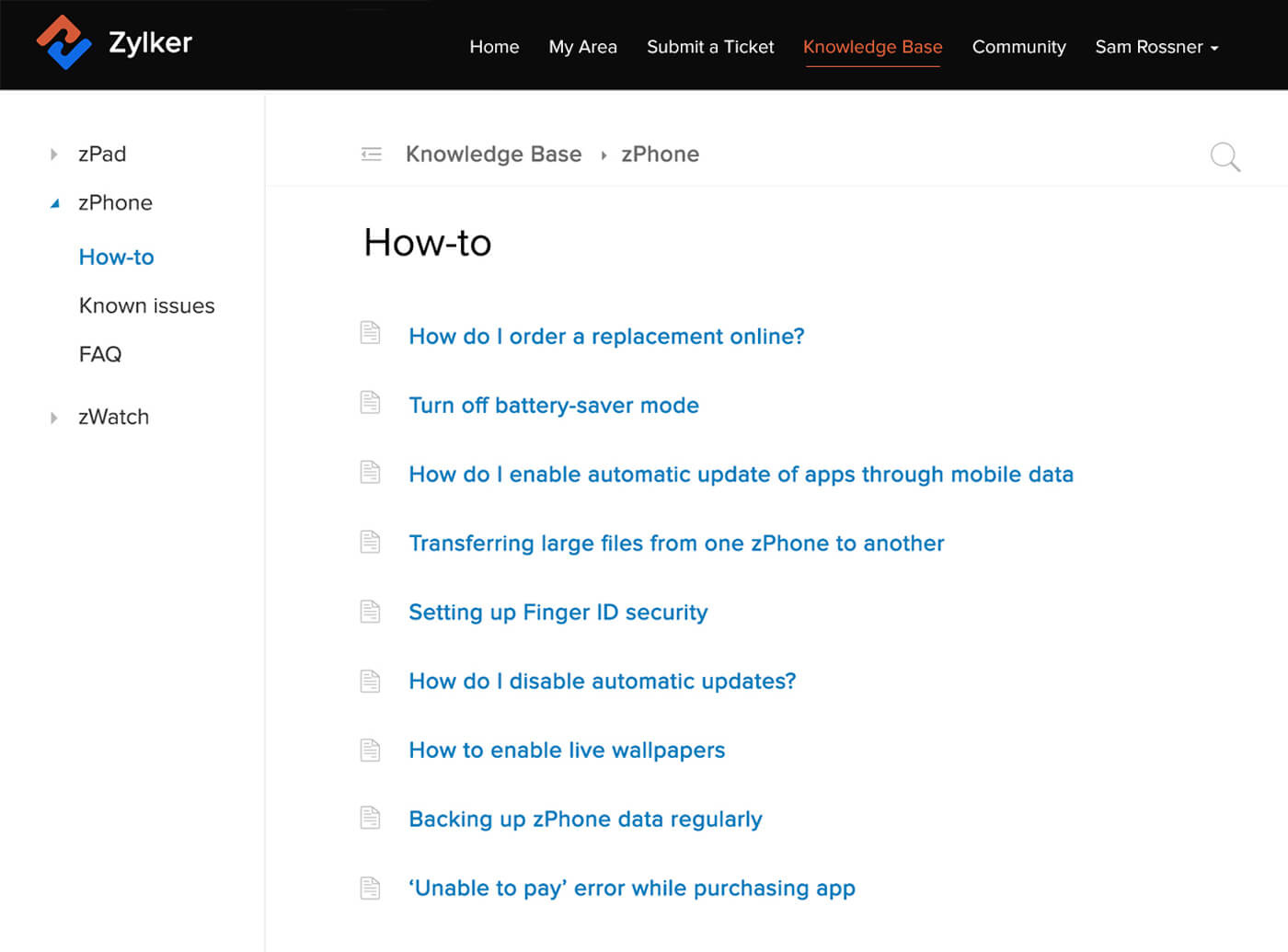
Zoho Desk helps brands design how-to articles to build their knowledge base. (Source: Zoho Desk)
Stats on Customers’ Perception of Customer Service Quality
Consumers’ perception of customer service quality may be far from what a company expects or self-reports. Check out the customer service facts below to better understand what consumers think about and expect from businesses.
7. Almost half (47%) of consumers in North America are not impressed with the customer service of businesses they buy from.
Takeaway: While 75% of small businesses in North America rate their customer service highly, many consumers report the customer service they encounter feels like an afterthought. To prevent this from happening, refine your customer service in such a way that you deliver quick resolutions to issues that your customers encounter.
(Source: Zendesk)
8. Over 70% of customers expect a conversational care experience during their engagement with a business.
Takeaway: While we think Gen Z or Millennials are driving the social trend in customer service, more than two-thirds of customers aged 40 and above are also seeking conversational care experiences. This tells businesses that there are many opportunities to set up omnichannel platforms that connect all their service channels to provide a seamless customer experience. It also highlights the power of personal touch in customer service for small businesses.
(Source: Zendesk)
9. 64% of consumers trust most companies to meet their needs & expectations.
Takeaway: While 64% is considered the majority, there is still room for improvement regarding trust. Seventy-six percent of businesses say they have the capacity to meet customer needs. There are steps you can take to strengthen their trust in your company. Some of the best customer service practices include maintaining excellent customer care, publishing customer reviews, and ensuring customers can easily reach you through various channels.
(Source: Salesforce)
10. 77% of customers trust companies to make honest claims about their products & services.
Takeaway: The figure above reflects a 9% increase from 2020 to 2022, signifying that customers’ trust in businesses is increasing. In addition, 75% of consumers now trust that businesses act with customers’ best interests in mind. However, businesses should aim to sustain this trust because negative feedback and experiences could sway customers’ purchasing decisions at any time.
(Source: Salesforce)
11. The majority (88%) of customers agree the experience a company provides is as important as its products or services.
Takeaway: Most customers (56%) expect a personalized experience from their interactions with a business. In fact, 62% expect a company to anticipate their needs. This data highlights the importance of providing excellent customer service to keep customers happy.
(Source: Salesforce)
12. 59% of customers say it feels like most businesses need to improve the training of their customer service agents.
Takeaway: Having a dedicated customer service team is not enough—you have to ensure they are equipped to do their job. One of the critical areas of having a sound customer service strategy is building and training your team. This includes coaching them on processes and procedures, handling difficult customers, familiarizing them with information on products and services, and teaching them how to use your customer service software.
(Source: Zendesk)
Pro tip: Having a solid customer service program is one of the first steps to improving the quality of your company’s service. Start by assessing both your customers’ needs and your organization’s weaknesses to come up with a good strategy. Download our free customer service program template and use it as a guide for building a training program for your support team.
Customer Service Statistics on Building a Support Team
Customer support impacts several aspects of your business, including marketing, customer acquisition, retention, and profit. This is why it takes time to build an excellent team that can perform their roles well. Here are some customer service response time statistics and customer service facts about support agents’ performance, methods of learning, performance metrics, and top areas of focus.
13. Only 26% of support agents in small businesses in North America feel empowered to perform well in their roles.
Takeaway: The majority of small businesses agree that service agents play a key role in customer retention rates. Unhappy agents can dampen the quality of your customer service and lead to dissatisfied customers. Take good care of your agents to prevent them from feeling burnt out and undervalued. You can do this by providing them with the right training, tools, and flexibility they need to create better experiences for your customers.
(Source: Zendesk)
14. Customer service professionals named peer relationships (54%), conferences (50%) & learning from formal mentors (39%) as their top methods for upskilling.
Takeaway: These findings highlight the importance of a solid team structure and collaboration processes, especially in a modern world with hybrid work setups. For businesses, this means allowing remote information sharing, virtual conferences to learn new skills, and shared learning.
(Source: HubSpot)
15. The top metrics used to assess service agent performance are customer satisfaction (74%) & speed of resolution (38%).
Takeaway: More often than not, customer satisfaction (CSAT) is the difference between success and failure because it reflects the health of your business. Time-to-resolution also impacts customer sentiment and service agents’ performance. Service level agreements (SLAs) are an effective tool for prioritizing tickets and ensuring agents meet customer expectations on ticket resolutions.
(Source: HubSpot)
16. Customer care leaders focus on building trust with employees (34%) & acting on employee feedback (24%) to retain top talent.
Takeaway: Three out of five service team leaders said they prioritize attracting, training, and retaining talent. Aside from building trust and listening to employee feedback, you can build better organizational cultures by providing opportunities for growth and aligning employees’ daily work with your company’s overarching goals.
(Source: McKinsey)
Pro tip: One way of increasing employee engagement and increasing productivity is using the gamification feature of your customer service software. Read our expert Freshdesk review to explore how this platform lets agents complete tasks to earn points and rewards. This fosters healthy collaboration and competition among agents, helping to improve their performance.
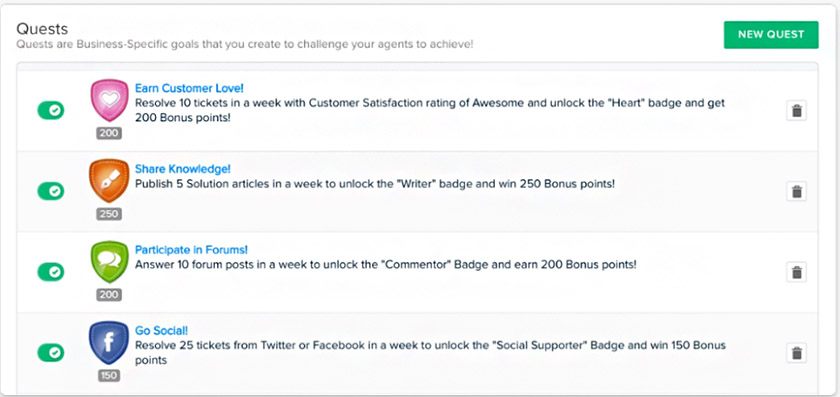
Helpdesk gamification (Source: Freshdesk)
Customer Service Stats on Choosing the Right Support Channels
There are several factors to consider when choosing customer service channels for your company. These include your team’s capacity, your customers’ needs, and industry trends. The following facts about customer service will help you gain insight into the most popular support channels in order to choose the right ones for your business.
17. Customer inquiries over social channels have increased by 36% since 2021.
Takeaway: Nowadays, customers are increasingly turning to social media for inquiries about products and services. With this in mind, businesses should ensure their customers can connect with them via social channels, such as Facebook, Instagram, or Twitter. Invest in customer service software that tracks social media interactions and automatically turns them into support tickets for a seamless customer and agent experience.
(Source: Zendesk)
18. 65% of Gen Z & Millennials prefer engaging with companies through digital channels.
Takeaway: Younger customers generally prefer to engage and buy online rather than through physical stores. Meanwhile, only 57% of Gen X and 42% of Baby Boomers prefer to engage through digital channels. With this trend in mind, it is best to train agents on how to personalize interactions according to the age group of their customers.
(Source: Salesforce)
19. Customers’ top preferred channels for engagement are phone (59%), email (57%), in-person (46%), online chat (42%) & mobile app (28%).
Takeaway: The other channels that made it to the list are messenger apps (27%), social media (21%), video chat (21%), text messaging (19%), and online portals (18%). Customers have been consistently turning to different channels to connect with companies. However, online channels are now rising through the ranks. Businesses should adapt to these changes and make sure that their customers can reach them easily through their preferred channels.
(Source: Salesforce)
Pro tip: For easier handling of customer requests, read our in-depth Zoho Desk review to learn how an omnichannel service platform can streamline customer service issues. This provider allows you to view and respond to tickets from various channels (including email, social media, and web forms), all from a single window.
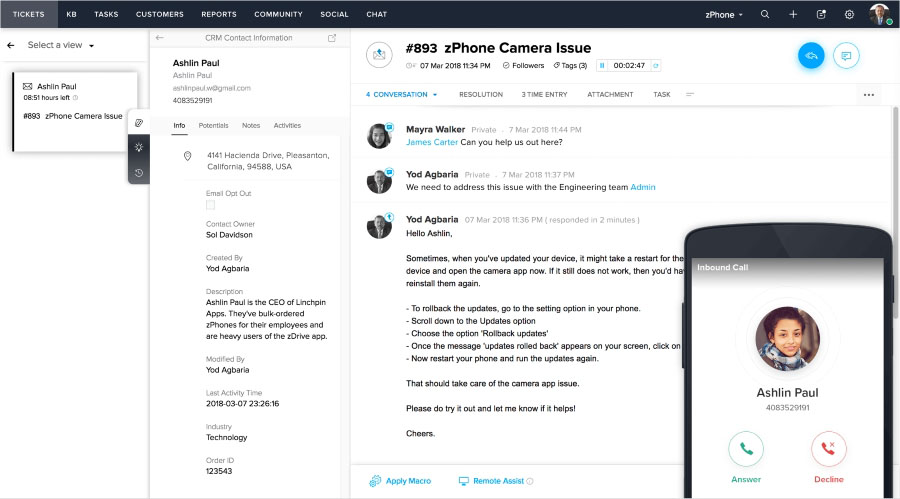
Zoho Desk’s omnichannel service platform (Source: Zoho Desk)
Statistics on Customer Frustrations
Customer frustration can be triggered by varying factors, including poor products, experiences, and customer service interactions. Read the following facts about customer service woes to understand the key factors contributing to consumers’ frustrations.
20. More than half (54%) of customers are frustrated with the number of questions chatbots ask before routing them to a live agent.
Takeaway: More than half (57%) of companies blame customers’ frustration with chatbots on their ad hoc approach to this technology’s integration. Many of them have yet to realize the full benefits of artificial intelligence (AI). One way to address this issue is to train chatbots to directly address the concern of customers. Another is to ensure customers are routed to a human agent if their concerns cannot be addressed using your knowledge base.
(Source: Zendesk)
21. Only 13% of customers think it takes a little effort to resolve their concerns.
Takeaway: Customer interactions with support teams appear fragmented because of hold times, call transfers, and agents who are ill-equipped to handle their concerns. Some businesses offer self-service support options to ease the workload of human agents. Others implement chatbots and account portals to ensure a seamless experience for their customers.
(Source: Salesforce)
Stats on the Challenges of Customer Service Agents & Teams
Customer care agents and leaders face different challenges in their respective roles. These include dealing with demanding customers, lack of budget for the team, employee attrition, and high call volumes. The stats below give us a clearer picture of the problems they encounter.
22. The top challenges of service agents are dealing with upset customers (52%) & prioritizing customer questions (51%).
Takeaway: Based on this study, fast-growing companies receive more support requests regarding complex issues compared to their slower-growing competitors. To address these top challenges, use service software that can automatically prioritize customer requests and route them to the right agent, if needed.
(Source: HubSpot)
23. The top challenges of service team leaders in growing companies are not having enough time daily (50%), organization & follow-up (31%) & lack of budget (30%).
Takeaway: Train your service leaders on how to deal adequately with your customers. This way, they are able to efficiently manage their work time. Also, ensure your team leaders have a clear understanding of your organization’s setup and system for follow-ups to avoid miscommunication issues. As for companies with limited budgets, you can maximize your resources by investing in low-cost or even free customer service software to automate manual tasks.
(Source: HubSpot)
24. 40% of companies still view customer service as an expense rather than an investment.
Takeaway: It is worth noting that 30% of service leaders named lack of budget as one of their team’s top challenges. Given these numbers, further education is needed to emphasize the positive impact of customer service on revenue. For small businesses, putting together a customer service team can seem costly at first, but it pays off in the long run as it drives customer retention and loyalty.
(Source: HubSpot)
25. Competitor recruitment (58%) & employee dissatisfaction (39%) are the top-cited reasons for employees leaving customer care organizations.
Takeaway: Almost half of service team managers report employee attrition in the past year, and this affects the capacity of an organization’s customer care team. Other top-cited reasons for agents leaving are lack of advancement potential (31%) and poor work-life balance (30%). In light of these stats, make sure your agents are happy by providing them with adequate training, competitive compensation packages, growth opportunities, and work-life balance.
(Source: McKinsey)
26. 41% of service team leaders say it takes three to six months to train a new agent for optimal performance.
Takeaway: A high employee turnover rate could prove costly for organizations. This is why you should strive to retain talent by keeping them happy as long as they are performing their job well. Read our article on employee retention to learn strategies for retaining your top talent.
(Source: McKinsey)
27. 61% of customer care leaders report higher call volumes & more contacts per customer.
Takeaway: The same group of respondents has reported a wider customer base, which contributes to higher call volumes and more complex interactions. While this is a sign of growth for a business, the increasing number of calls could put a strain on contact centers and affect the quality of customer service. With the aid of a good customer service tool, businesses can manage their calls more efficiently in order to lessen the strain on their agents.
(Source: McKinsey)
Pro tip: If you are concerned about the budget for your small service team, read our expert review of HubSpot Service Hub to learn how using a free customer support tool can help. It has a free plan that supports unlimited users and offers advanced tools like canned responses, conversational chatbots, and email tracking.
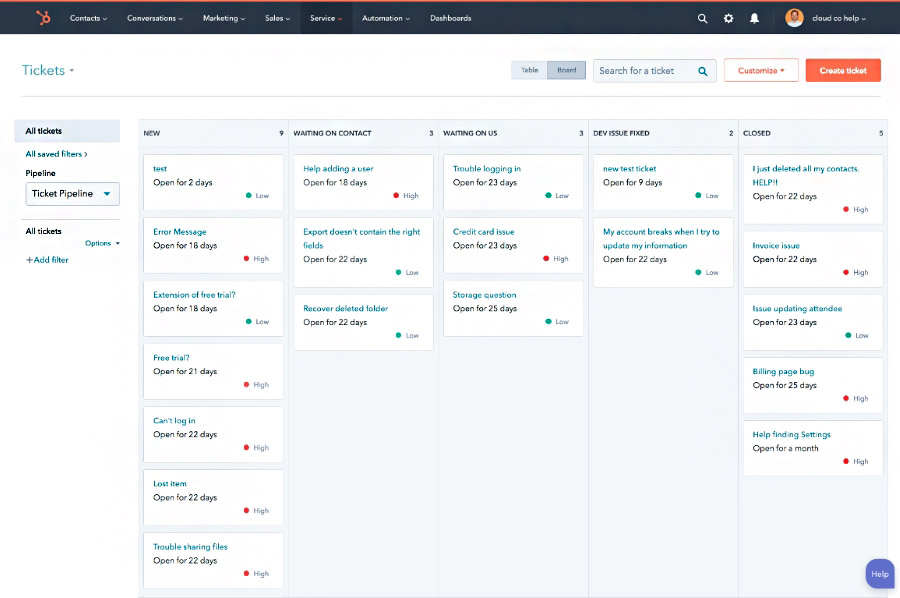
Free ticketing system (Source: HubSpot Service Hub)
Customer Service Tools Statistics
With the help of customer service software, businesses can easily manage customer communication touchpoints and respond to queries from a centralized platform. Below, you can find stats on the top tools used by the customer service industry and the benefits of using them.
28. The top three tools that businesses use to enable customer service teams are help desk systems (53%), knowledge bases (52%) & a shared email alias (47%).
Takeaway: Help desk systems combine multiple tools, including knowledge bases, how-to guides, automated chatbots, and customer support channels. All these tools aim to meet the demands placed upon service and support teams. Depending on the infrastructure and needs of your business, you can opt for a standalone ticketing solution for email support requests or go for a fully featured help desk software.
(Source: HubSpot)
29. 60% of high-growth companies use a help desk system to enable their customer service team.
Takeaway: Less than half of low-growth companies use a help desk system to help their customers, and only around 30% of no-growth companies do the same. Companies differ in the use of technology at different growth stages. Smaller service teams might start out with a ticket management system to monitor email support requests. As your company grows and integrates more service channels, you may need a more comprehensive tool like a help desk system.
(Source: HubSpot)
30. 91% of businesses say their help desk system increases their productivity.
Takeaway: Clearly, the majority of businesses agree that help desk systems are effective in increasing their productivity. Customers nowadays have access to various channels to connect to customer service. A help desk system consolidates all these channels in a single platform, creating a smoother experience for both customers and support agents.
(Source: HubSpot)
31. Almost two-thirds (65%) of service leaders attribute decreased call volumes to their improved self-service channels.
Takeaway: You can reduce transactional and repetitive calls by implementing a self-service channel for your customers. Doing this frees up your agents’ time so they can focus on resolving more difficult issues that customers face.
(Source: McKinsey)
Pro tip: Customer service software like HubSpot Service Hub lets you store customer data and manage tickets from a single platform. This provider also comes with live chat features, shared inboxes, and in-app telephony. Check out our guide to the best customer service software for small businesses to explore other similar options.
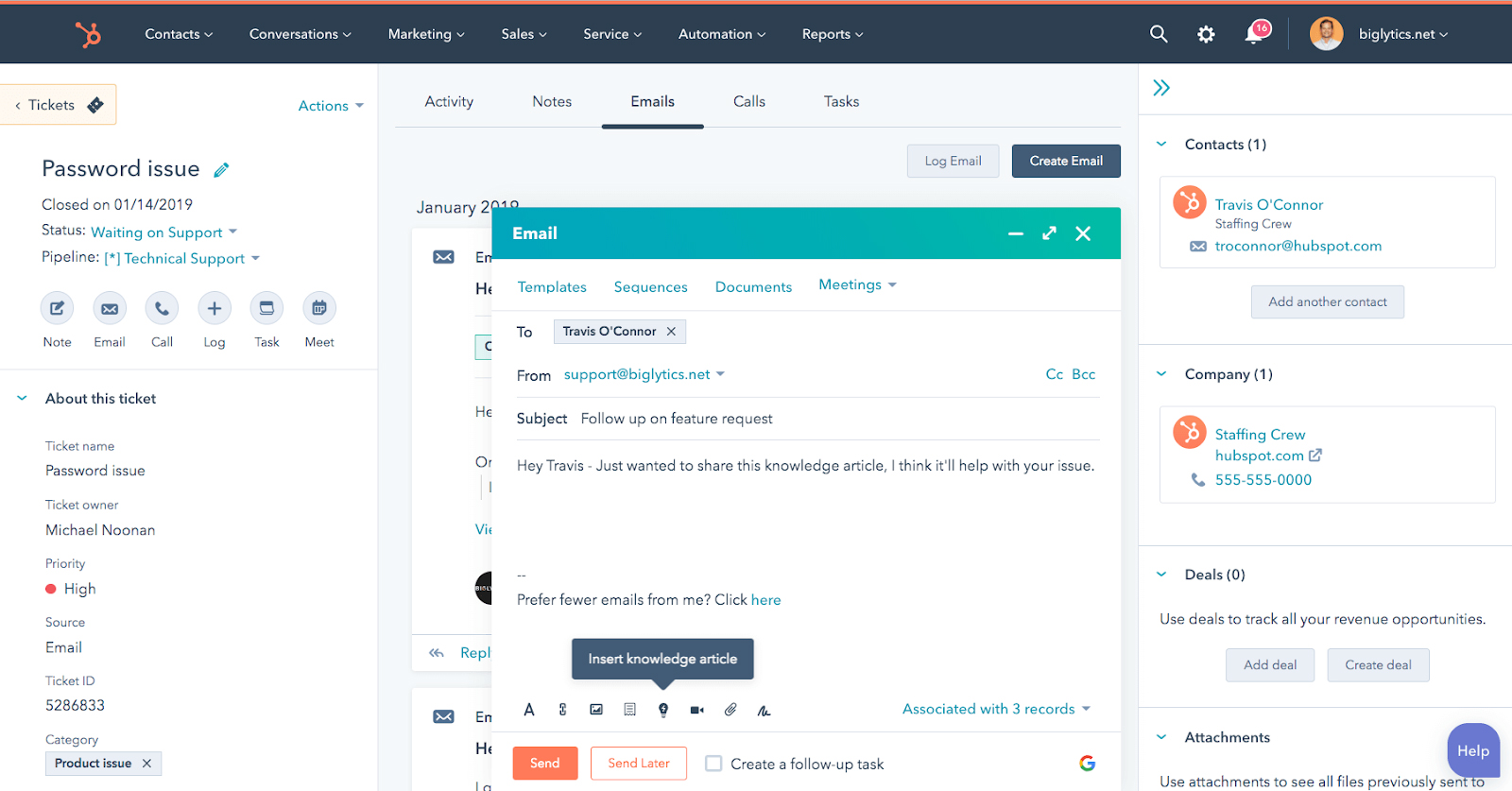
HubSpot Service Hub makes it easy for customer support agents to answer email queries straight from the platform with its email functionality. (Source: HubSpot Service Hub)
Customer Service Stats on Artificial Intelligence
Artificial intelligence (AI) customer service involves software programmed to respond to customer requests in such a way that it simulates human interaction through natural language processing (NLP). A growing number of businesses have already integrated AI into their customer service technology, but some are still holding back. Read the statistics below to learn about its return on investment (ROI) and what customers think about it.
32. Nearly 20% of business leaders say their ROI from using AI or automation is ‘very high.’
Takeaway: Chatbots are able to respond to customers at all hours, create a ticket for human agents to pick up once they’re back in the office, and point customers to relevant information. Through these capabilities, chatbots reduce the cost of paying live agents to work around the clock. They also help increase revenue by engaging with customers across multiple support channels.
(Source: Zendesk)
33. 25% of businesses plan to start offering AI & chatbot-guided self-service, but half of them say chatbot performance is disappointing.
Takeaway: Among large and small companies, 26% have already allotted at least a quarter of their customer service tech budget to AI. Unfortunately, not everyone knows how to maximize this technology. Before you implement AI in your customer service, make sure that your team gets sufficient training on how to use it properly.
(Source: Zendesk)
34. 42% of companies worldwide are allocating up to 24% of their customer service technology budget to AI.
Takeaway: Customers hate repeating the same question to several agents and waiting on hold while the agent searches for answers to their queries. Conversational customer service addresses these issues by offering fast, personalized, and seamless interactions across multiple channels—including web, mobile, and social apps. These are among the reasons why more businesses are investing in AI for their customer service.
(Source: Zendesk)
35. While 69% of customers are open to using AI to improve their experience, 72% are concerned with its unethical use.
Takeaway: The rising popularity and integration of AI technology in customer service have also increased customer awareness around its value and pitfalls, while the majority of them trust that businesses will use it ethically to improve their overall experiences. That said, businesses should adopt consent-forward approaches to gathering information that can be used to tailor customer experiences.
(Source: Salesforce)
Pro tip: Chatbots are typically programmed using conversation workflows to provide information to customers. A tool like ChatBot has helpful bot features like a no-code chatbot builder, a chatbot testing tool, and prebuilt conversation templates.
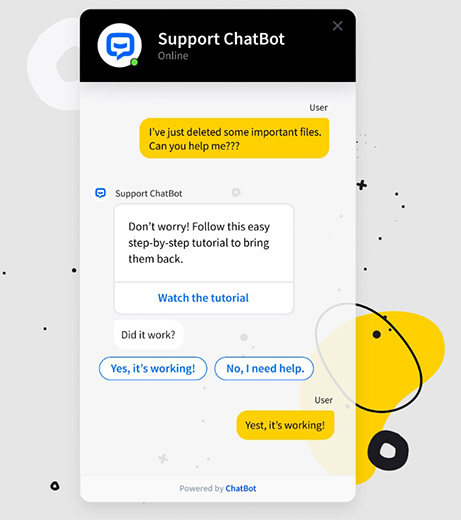
ChatBot for support (Source: ChatBot)
Customer Satisfaction & Experience Statistics
Customer satisfaction (CSAT) measures how well a company’s products, services, and customer experience meet its consumers’ expectations. Check out the statistics below to learn how you can improve your business’ customer satisfaction, retention, and loyalty.
36. The most common ways of actively listening to customers are tracking customer satisfaction (70%), sending surveys (65%) & monitoring online reviews (60%).
Takeaway: Monitoring CSAT scores and sending surveys after a customer interaction are excellent ways to assess your team’s success in meeting customer expectations. Customer feedback surveys also make consumers feel heard and valued. In addition, monitoring online reviews is a great way to listen to what your customers are saying about your business.
(Source: HubSpot)
37. More than half (55%) of businesses with self-reported exponential growth say they send out surveys after every customer interaction.
Takeaway: Based on this study, more frequent surveys are associated with higher self-reported growth. Only 38% of high-growth, 34% of low-growth, and less than 30% of no-growth businesses do the same. Surveys are essential because they help you understand your customers and know what they expect from you. Doing this also lets you pinpoint areas in your business that need improvement, such as product features and service quality.
(Source: HubSpot)
38. Customer service teams’ top priorities include excellent customer experience, (45%), customer success (37%) & customer retention (35%).
Takeaway: An excellent customer experience is made possible by proactive customer service, which could influence customer loyalty and retention. All these contribute to increased revenue for a business. Therefore, it is important to keep on striving to improve the quality of your service in order to facilitate business growth.
(Source: HubSpot)
39. In the past year, customers have switched brands due to better deals (66%), product quality (58%) & customer service (48%).
Takeaway: Last year, 71% of customers switched brands at least once. While better deals and product quality are the top drivers of brand switching, improved customer service also plays a major role in this defection. This gives businesses hope that they can still attract customers from competing brands if they offer better service.
(Source: Salesforce)
40. Most (56%) consumers will likely buy from a company with an established loyalty program.
Takeaway: Loyalty programs can increase the likelihood of attracting customers, but almost two-thirds of consumers don’t actually redeem rewards. This could be due to the difficulty of tracking loyalty rewards and manually redeeming them. To remedy this, you can use customer loyalty program software to automate your rewards program.
(Source: Salesforce)
Pro tip: To assess the quality of your customer service, you must identify specific parameters to measure customer satisfaction. For example, read our comprehensive Freshdesk review to discover how it lets you send customer satisfaction surveys to clients after each case is resolved. You can also ask them to leave comments on particular areas they found helpful or need improvements. This helps increase your overall customer satisfaction rates.

Freshdesk’s multilingual feedback surveys (Source: Freshdesk)
Bottom Line
Customer service is a crucial part of your overall business. Remember, the best products and services attract customers, but excellent and reliable customer service makes them loyal to your brand. Use these customer service stats as a reference to improve the various aspects of your customer service activities, including training your team and providing personalized service to clients.